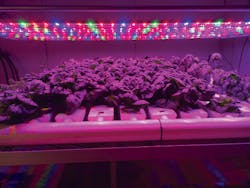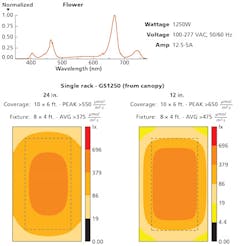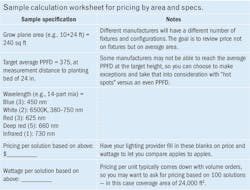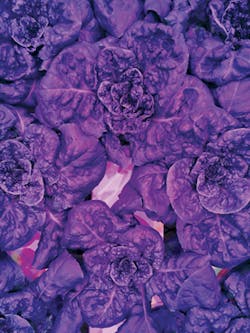With LED-based horticultural lighting on the rise, specifiers and end users need education to select the optimal fixtures for projects. RYAN MITCHELL and CHARLIE SZORADI deliver a guide to navigating spec sheets and performance calculations for best results.
The Earth's population is projected to reach 10 billion by 2050, and there are growing concerns about water, energy, and food availability for such a high number of people. To maintain our current water supply and produce enough food to feed our fellow human residents, several different practices must be adopted within the agricultural sector. One potential solution to the problem is growing vegetables in water through hydroponics, aquaponics, or aeroponics. LED-based horticultural lighting works as an excellent companion technology to enhance crop production for indoor applications, especially in warehouses - in what is known as vertical or urban farming - versus greenhouses.
Interested in articles & announcements on horticultural lighting?
The three water systems are soil-less methods of agriculture that can produce 5× the amount of food in the same space as typical outdoor agricultural methods. Furthermore, these practices utilize at least 90% less water than the irrigation practices used in outdoor agriculture. With food and water availability possibly being the greatest future challenge facing humankind, these systems will provide significant relief to those concerns.
One common question with such agricultural systems is how the yields compare to soil-grown harvests. As stated earlier, these systems provide the ability to grow roughly 5× the amount of food in the same space compared to outdoor agriculture. The ability to stack the water and lighting systems in shelves allows for a condensed and efficient use of space. Along with that, utilizing LED grow lights designed to deliver appropriate light spectra for each crop, provides more photosynthetic active radiation (PAR) than what most plants receive from the sun (Fig. 1). For instance, Mount Vernon, which is one of the most notable farm towns in Iowa, receives a maximum of about 14 hours of photosynthetic light a day in the summer, but in the winter it can drop to as low as eight hours of light. When equipped with horticultural solid-state lighting (SSL), plants reach their maximum photosynthetic potential every day. Growers just need to be careful about giving their crop too much of the heat energy that comes with the any light source. Therefore, periods of no light exposure must be set aside each day for plants. The reduced heat and the lower electricity operating costs of LEDs have opened a whole new chapter in agriculture.
Reaping the economic benefits
With greater yields than the common outdoor methods of agriculture, the next concern is whether these horticultural systems are economically efficient. The quick answer is "yes" - with an asterisk - based on three key factors: type of plant; sales region; and cost of electricity
People outside of the agriculture industry might assume that cannabis, with medical and recreational marijuana, is the only "cash crop." Since cannabis takes multiple months to grow and grows multiple feet tall prior to harvest, it uses up more real estate - horizontally and vertically - than other crops like lettuce and micro-greens. Indoor farmers can "rack and stack" leafy greens four or five high and turn the crops more than once a month. California lettuce is shipped all over the US, and the cost at wholesale is often about $1.50 per head of romaine. The trans-continental cost of each head of lettuce with diesel fuel is about $0.30, while horticultural SSL can grow the same head of lettuce for less than $0.15. Fresh, local, and organic vegetables are now more affordable than ever with LEDs.
For building illumination, LED manufacturers and solution providers often look to retrofit existing buildings in regions that have higher-than-average electricity costs. The savings payback comes faster with higher cost/kWh. For indoor farming, the opposite is true, because the lower the cost/kWh the lower the cost of goods sold for each plant in the harvest. Given that off-peak electricity (typically late night to early morning) is in less demand and lower cost than peak power (during the day and evening), next-generation indoor farmers will be able to power their LEDs using off-peak electricity and supplement as needed with skylights and clearstory natural light during the day. Using remnant warehouses with LEDs and any of the water-saving systems is a cost-effective way to overcome the challenges of the water, energy, and food security nexus.
A guide to buying grow lights
Finding the right grow light for your horticulture project can be a difficult and daunting task. Units of measurement such as wattage, wavelength, lumens, PAR, micromoles (μmol), and photosynthetic photon flux density (PPFD) commonly lead to misconceptions over the quality and efficiency of a grow light. So how can a buyer select the right grow light to fulfill their needs? This buyers guide includes two key parts: navigating specification sheets and performance calculations.
Navigating specification sheets. First, let's look at what is not important. Lumens are a common unit of measurement in lighting spec sheets. The issue with lumens is that they are measure of responsivity by the human eye to various energy wavelengths (visible light output). If a lighting company's representatives are promoting lumens for its grow lights, then they are unqualified and a waste of the buyer's precious time.
Understanding the correct color of the lighting is a crucial aspect for any horticulture venture. Whether you are looking for full spectrum, a wavelength combination, or a specific wavelength, having the right color is essential for optimal growth in plants. You should ask a lighting expert at the company from which you may purchase the products, or do some scholarly research on what wavelengths are best for certain plants. This will assist in high yields and optimal growth.
Comparing wattage is another way many users decide on horticultural lighting. The issue with looking at just the wattage is that radiometric lighting efficiency can vary greatly through different brands of products. Some companies' grow lights may be higher in wattage than others, however, the efficiency may be weaker in comparison to the output of photosynthetic light. Therefore, a fixture with a higher wattage does not necessarily mean it is more powerful and beneficial when used for horticulture applications.
Let's explore the indicators of performance and efficiency relative to micromoles, PPFD, and PAR.
Micromoles indicate how many photons of lights are emitted. PPFD is the number of micromoles emitted in a certain area per second. PAR is the amount of photosynthetic light emitted in the visible range of 400-700 nm; this drives photosynthesis. Now these all sound like equally great metrics to consider when searching for a grow light; however, PPFD includes both photosynthetic light and area. This makes it a very efficient comparison tool when looking at different horticultural lighting products.
One aspect to note with PPFD is the area used in the measurement. Look for a peak PPFD number (PPFD = μmol/m2/s) and an average PPFD. These metrics will reveal how much photosynthetic light is emitted directly under the grow light along with the surrounding area. This is because some lights have an extremely high PAR rating directly under the light but a drastic decrease in PAR in the surrounding area. So it is crucial to determine the PPFD average for the area in which you are hoping to grow plants for each individual grow light (PPFD = PAR/m2). Even distribution of PPFD will help create more even growth of the plants.
Performance calculations. To compare the cost and performance of two or more grow lights, follow these steps to make sure the comparison is apples to apples.
Step 1: Ask your contact at the lighting manufacturer, supplier, or the representatives to provide information on their technology based on meeting the specific needs of a given scenario, such as the one in the table, given sample specs for comparing fixtures.
Step 2: Do the quick math. First, divide the cost of the solution by the square footage of the solution coverage area at the average PPFD level to get grow light equipment cost/ft2. Next, divide the wattage of the solution by the square footage of the solution coverage area to get W/ft2. Finally, compare the technology - the lowest cost and W/ft2 are the winners.
Following is a frame of reference on cost based on an example from Independence LED Lighting (Fig. 2) with similar specs as in the table. The LED grow light GS1250 is a 4×8-ft linear module rack system with a coverage area of 60 ft (6×10 ft) and 1250W power consumption. Note that this system is designed to replace two 1000W metal-halide (MH) fixtures or four 400W fixtures that typically have a ballast factor greater than 450W each. To meet the needs of the targeted 240 ft2, the grow light system would need four racks. The cost per rack will vary based on wavelength/diode selection but is often between $1750 and $2500.
For this exercise, four racks at $2000 each adds up to $8000. The wattage of 1250W per rack × 4 = 5000W for the horticultural lighting solution area. So then calculate the racks as $8000/240 ft2 = $33.33 per ft2 for the LED grow light equipment. And electricity consumption would be calculated as 5000W/240 ft2 = 20.8W/ft2.
In comparison, the cost and power consumption of an MH horticultural lighting system for the same area would be calculated as follows. Four MH fixtures at 450W each × 4 (racks) = 16 fixtures using 7200W. The cost of $185 per fixture × 16 fixtures = $2960 total for the equipment. Take the total of $2960/240 ft2 = $12.33 per ft2 for the comparable MH grow light equipment. Finally, the electricity consumption can be determined as 30W/ft2 (by calculating 7200W/240 ft2).
The LEDs are more expensive upfront but more efficient with 30% lower ongoing operating costs. Now, we want to answer the question "How much savings comes with the more efficient lights?"
We need to set two key variables that you can adjust accordingly. For the purpose of this calculation, we will use daily hours of illumination - 16 hr (5840 hr/year), and cost/kWh - $0.12 (US average).
Key square footage data points are:
• Ongoing energy (30W for LED - 20.8W for MH) = 9.2W saved/ft2
• The upfront cost difference ($33.33 LED - $12.33 MH) = $11 saved/ft2
The related formulas are:
• Watts saved/1000 × Annual hours = Annual kWh savings/ft2
• Annual kWh saved × Cost/kWh = Annual cost savings/ft2
• Added upfront cost/Added annual cost savings gives the payback time
So, for example, the calculations would result in:
• 9.2W saved /1000 × 5840 hr = 53.7 Annual kWh savings/ft2
• 53.7 Annual kWh saved × $0.12 = $6.44 Annual cost savings/ft2
• $11 Added upfront cost/$6.44 Added annual cost savings = Payback time is 1.7 years
Over the long 100,000-hour life of many LEDs, the payback in just over a year and a half presents a favorable business advantage. For a facility with 24,000 ft2 of grow area, the annual savings of $6.44 adds up to $154,000 per year and more than $1.5 million over 10 years. An increasing number of LED manufacturers and value added resellers (VARs) offer $0 upfront cost financing options. So in your review of product options, make sure to ask about flex payment and financing plans; then the monthly energy savings can pick up the cost of the LEDs rather than your working capital upfront.
Step 3: Order samples of the two or three horticultural lighting solutions that are mathematical winners with the lowest equipment cost/ft2 and the lowest W/ft2. Ask the manufacturer to refund the cost of the samples if you return the technology within 90 days.
Step 4: Request refinements to the wavelengths if necessary and review monthly financing options for all or partial payment of the equipment.
Step 5: Place a purchase order with the company that delivers on the mathematical promise and on the in-field performance to meet the needs of your plants and your business.
Conclusion
As we have explored, not all LED horticultural lighting is created equal. Let's recap the main points when selecting LED grow lights. Ask manufacturers for photometric layouts to see the PPFD at target elevation levels, and look for the most even PPFD distribution over hot spots. Line up fixture comparisons based on apples to apples solutions that cover the same area at the same wavelength and PPFD levels. You can even out the fixture variables by breaking the performance down to the square foot. Use the equipment cost per square foot and the electricity operating cost per square foot to guide your decisions. Test samples before making a large purchase, and ask the manufacturer in advance to agree to refund the cost of samples that you don't keep. Last, financing will allow the monthly savings to help pay for the lights and maximize your return on investment.
RYAN MITCHELL is account manager and CHARLIE SZORADI is chairman and CEO at Independence LED Lighting (independenceled.com).
STEM factors into leading-edge agriculture
The educational benefits when using advanced agriculture systems with grow lights are immense. Science, technology, engineering, and math (STEM) is a focus point of many K-12 schools and universities in the US and beyond. Hydroponics, along with other systems like it, incorporates all aspects of STEM, which makes it a highly effective tool to utilize in schools. With the lighting, students can learn about how different wavelengths are optimal for photosynthesis for different plants. They can also build their own systems from scratch, which forces them to understand how the water will flow, maintaining pH and water temperature, and monitoring the electrical conductivity (EC) rating which reveals how much fertilizer salts are in the water. These experiments will be highly engaging for students and provide an excellent way to better understand the science behind these agricultural systems.
Another major benefit for utilizing hydroponic, aquaponic, and aeroponic systems in combination with horticultural lighting in school is the potential nutritional value - especially in inner-city schools. In many cultures, children are becoming more susceptible to becoming overweight and obese, and it is crucial for students to have better nutritional options available. By having an agricultural system placed in a school, fresh vegetables can be readily available to students. Furthermore, the vegetables being consumed would come directly from the hands of the students. This will make it much more likely for adolescents to include vegetables in their daily diets since they could be working directly with them in a consistent manner. The combination of better nutrition and a more engaged science curriculum is an example of why these systems need to be put to use in schools.
With so many benefits to fully-integrated horticultural systems, the tipping point for next-generation agriculture may arrive sooner than many expect. The lighting is one of the major equipment costs. Buyers often look at price and wattage as their gauge for effectiveness. The guidelines explained in the article may help steer testing and purchase decisions.









